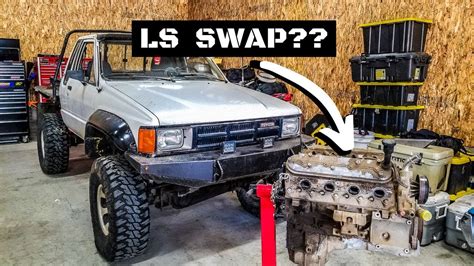Revamp Your Ride: Unleash the Power of LS in Your Toyota Pickup

LS Swap in Toyota Pickup: A Comprehensive Guide
The Toyota pickup, also known as the Hilux, is a legendary vehicle renowned for its reliability, durability, and off-road capabilities. However, some enthusiasts seek to enhance the performance and capabilities of their Toyota pickups by performing an LS swap, which involves replacing the original engine with a General Motors LS engine.
Benefits of an LS Swap in Toyota Pickup
There are several compelling reasons why enthusiasts opt for an LS swap in their Toyota pickups:
- Increased Power and Performance: LS engines are known for their impressive power output and torque, significantly improving the acceleration, towing capacity, and overall performance of the Toyota pickup.
- Reliability and Durability: LS engines are renowned for their reliability and durability, ensuring a long service life with minimal maintenance requirements.
- Parts Availability and Affordability: LS engines and their components are widely available and relatively affordable, making them a cost-effective option for engine upgrades.
- Versatility and Customization: LS engines offer a wide range of performance modifications and aftermarket support, allowing enthusiasts to tailor their engine's performance to their specific needs and preferences.
Choosing the Right LS Engine for Your Toyota Pickup
When selecting an LS engine for your Toyota pickup, several factors need to be considered:
- Engine Size: LS engines are available in various displacements, ranging from 4.8L to 6.2L. The choice of engine size depends on your desired power output and performance goals.
- Engine Generation: LS engines have gone through several generations, each with its own unique characteristics and features. Research the different generations to determine which one suits your needs and budget.
- Fuel Injection System: LS engines are available with either a carburetor or fuel injection system. Fuel injection is generally preferred for its improved performance, fuel efficiency, and ease of tuning.
- Accessories and Components: Consider the necessary accessories and components required for the LS swap, such as engine mounts, exhaust manifolds, and wiring harnesses. Ensure compatibility with your Toyota pickup's chassis and drivetrain.
Preparing Your Toyota Pickup for the LS Swap
Before embarking on the LS swap, it is essential to prepare your Toyota pickup:
- Remove the Original Engine and Transmission: Carefully remove the original engine and transmission from the Toyota pickup, ensuring all necessary components are disconnected and removed.
- Prepare the Engine Bay: Inspect the engine bay for any necessary modifications or reinforcements to accommodate the new LS engine. This may include fabricating custom engine mounts or modifying the firewall for clearance.
- Upgrade the Fuel System: The LS engine may require a higher fuel flow rate than the original Toyota engine. Consider upgrading the fuel pump, fuel lines, and fuel injectors to ensure adequate fuel supply.
- Upgrade the Cooling System: The LS engine may generate more heat than the original Toyota engine. Consider upgrading the radiator, water pump, and thermostat to ensure proper cooling.
Installing the LS Engine and Transmission
Once the Toyota pickup is prepared, the LS engine and transmission can be installed:
- Install the Engine Mounts: Secure the LS engine to the Toyota pickup's chassis using custom or modified engine mounts. Ensure proper alignment and stability.
- Connect the Drivetrain: Install the transmission and connect it to the LS engine. Ensure proper alignment and engagement of the clutch or torque converter.
- Connect the Wiring Harness: Connect the LS engine's wiring harness to the Toyota pickup's electrical system. This may require custom wiring or modifications to the original wiring harness.
- Install the Exhaust System: Fabricate or modify the exhaust system to accommodate the LS engine's exhaust manifolds or headers. Ensure proper fitment and routing of the exhaust pipes.
Tuning and Calibration
After the LS swap is complete, the engine and transmission need to be tuned and calibrated:
- Engine Tuning: Tune the LS engine's fuel injection, ignition timing, and air-fuel ratio using a programmable engine management system (EMS). This ensures optimal performance and efficiency.
- Transmission Tuning: Tune the transmission's shift points and behavior to match the LS engine's characteristics. This ensures smooth and responsive shifting.
Testing and Troubleshooting
Once the LS swap is complete, thoroughly test the vehicle to ensure proper operation:
- Test Drive: Take the Toyota pickup for a test drive to assess its performance, handling, and any potential issues.
- Diagnostics: Perform diagnostic scans and checks to identify any fault codes or potential problems. Address any issues promptly.
Finishing Touches and Enjoying Your LS-Powered Toyota Pickup
With the LS swap successfully completed, you can enjoy the enhanced performance and capabilities of your Toyota pickup:
- Final Adjustments: Make any necessary adjustments or modifications to the suspension, steering, or brakes to optimize the vehicle's handling and performance.
- Cosmetic Enhancements: Consider cosmetic upgrades such as a new paint job, wheels, or interior modifications to complement the LS swap.
- Regular Maintenance: Maintain the LS-powered Toyota pickup according to the manufacturer's recommendations to ensure its longevity and optimal performance.